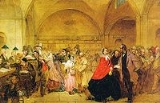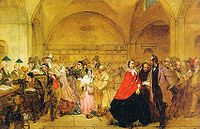
George Elgar Hicks
Encyclopedia

England
England is a country that is part of the United Kingdom. It shares land borders with Scotland to the north and Wales to the west; the Irish Sea is to the north west, the Celtic Sea to the south west, with the North Sea to the east and the English Channel to the south separating it from continental...
painter
Painting
Painting is the practice of applying paint, pigment, color or other medium to a surface . The application of the medium is commonly applied to the base with a brush but other objects can be used. In art, the term painting describes both the act and the result of the action. However, painting is...
during the Victorian era
Victorian era
The Victorian era of British history was the period of Queen Victoria's reign from 20 June 1837 until her death on 22 January 1901. It was a long period of peace, prosperity, refined sensibilities and national self-confidence...
. He is best known for his large genre painting
Painting
Painting is the practice of applying paint, pigment, color or other medium to a surface . The application of the medium is commonly applied to the base with a brush but other objects can be used. In art, the term painting describes both the act and the result of the action. However, painting is...
s, which emulate William Powell Frith
William Powell Frith
William Powell Frith , was an English painter specialising in genre subjects and panoramic narrative works of life in the Victorian era. He was elected to the Royal Academy in 1852...
in style, but was also a society portraitist.
Biography
Born on March 13, 1824 in LymingtonLymington
Lymington is a port on the west bank of the Lymington River on the Solent, in the New Forest district of Hampshire, England. It is to the east of the South East Dorset conurbation, and faces Yarmouth on the Isle of Wight which is connected to it by a car ferry, operated by Wightlink. The town...
, Hampshire
Hampshire
Hampshire is a county on the southern coast of England in the United Kingdom. The county town of Hampshire is Winchester, a historic cathedral city that was once the capital of England. Hampshire is notable for housing the original birthplaces of the Royal Navy, British Army, and Royal Air Force...
, George Elgar Hicks was the second son of a wealthy magistrate
Magistrate
A magistrate is an officer of the state; in modern usage the term usually refers to a judge or prosecutor. This was not always the case; in ancient Rome, a magistratus was one of the highest government officers and possessed both judicial and executive powers. Today, in common law systems, a...
. His parents encouraged Hicks to become a doctor and so Hicks studied medicine at University College
University College London
University College London is a public research university located in London, United Kingdom and the oldest and largest constituent college of the federal University of London...
from 1840-42. However, after three years "ardous and disagreeable study" Hicks decided he wanted to be an artist. Due to these circumstances, Hicks began training considerably later in life than most artists of the time. In 1843, Hicks attended Sass's Academy
Henry Sass
Henry Sass was an English artist and teacher of painting, who founded an important art school, Sass's Academy , in London, to provide training for those seeking to enter the Royal Academy. Many distinguished British painters received their early training here...
and by 1844 had entered the Royal Academy Schools.
In 1847 Hicks married Maria Hariss and six of their eight children were born in the seven years following. He did not achieve much success as an artist during this period and later referred to his art at this time as "small and unimportant." He blamed this on the fact he had little time to study art or interact with other artists, due to a busy family life.
In 1859, Hicks painted his first large genre painting, Dividend Day. Bank of England (exhibited at the Royal Academy in 1859) - following the success of Frith
William Powell Frith
William Powell Frith , was an English painter specialising in genre subjects and panoramic narrative works of life in the Victorian era. He was elected to the Royal Academy in 1852...
's paintings Ramsgate Sands and Derby Day at the Royal Academy. It was a typical genre painting, showing a scene from the Bank of England
Bank of England
The Bank of England is the central bank of the United Kingdom and the model on which most modern central banks have been based. Established in 1694, it is the second oldest central bank in the world...
and featuring a broad range of social classes. He painted several more large modern life paintings in the following years which were generally poorly reviewed by critics. These include The General Post Office. One minute to 6 (1860), Billingsgate Fish Market (1861) and Changing Homes (1862). Hicks' paintings were often of subjects that no other artists attempted, such as the General Post Office
General Post Office
General Post Office is the name of the British postal system from 1660 until 1969.General Post Office may also refer to:* General Post Office, Perth* General Post Office, Sydney* General Post Office, Melbourne* General Post Office, Brisbane...
and Billingsgate Fish Market
Billingsgate Fish Market
Situated in East London, Billingsgate Fish Market is the United Kingdom's largest inland fish market. It takes its name from Billingsgate, a ward in the south-east of the City of London, where the riverside market was originally established...
. Hicks was one of the few artists that showed lasting interest in the emulation of Frith's style and is generally considered Frith's principal imitator.
By the late 1860s, the popularity of genre painting had waivered and Hicks began to focus on historical subjects, leading to society portraiture
Portrait painting
Portrait painting is a genre in painting, where the intent is to depict the visual appearance of the subject. Beside human beings, animals, pets and even inanimate objects can be chosen as the subject for a portrait...
in the 1870s.
In 1884, Hicks remarried following the death of Maria in 1881. He retired in the 1890s and died a month before the declaration of World War I
World War I
World War I , which was predominantly called the World War or the Great War from its occurrence until 1939, and the First World War or World War I thereafter, was a major war centred in Europe that began on 28 July 1914 and lasted until 11 November 1918...
in 1914.
Further reading
- Hicks, G. E. A guide to figure drawing" (1869).
- Allmond, Rosamond. George Elgar Hicks: Painter of Victorian life (Geffrye MuseumGeffrye MuseumFounded in 1914, the Geffrye Museum is a museum specialising in the history of the English domestic interior. Named after Sir Robert Geffrye, former Lord Mayor of London and Master of the Ironmongers' Company, it is located on Kingsland Road in London...
, 1982).
External links
- G E Hicks online (ArtCyclopedia)
- Paintings by G E Hicks (Art Renewal Center)
- The representation of women in Hicks' paintings (University of Leicester)
- The General Post Office (1860, oil on canvas)
- An Infant Orphan Election at the London Tavern, 'Polling' (Oil on canvas, 1865 - Museum of LondonMuseum of LondonThe Museum of London documents the history of London from the Prehistoric to the present day. The museum is located close to the Barbican Centre, as part of the striking Barbican complex of buildings created in the 1960s and 70s as an innovative approach to re-development within a bomb damaged...
) - The latest arrival (Christie's)

